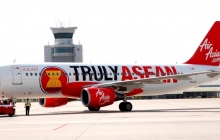AirAsia was launched in 2001 with the dream of making flying possible for everyone. Since then, AirAsia has swiftly risen to become the world’s best...
-

Tourism
Where to invest?
Tourism
Tourism has been one of the key growth sectors in ASEAN and has proven resilient amid economic challenges globally. The wide array of tourist attractions across the region has drawn 81 million tourists to ASEAN in 2011, up by 30% compared to 62 million tourists in 2007. Data from the Pacific Asia Travel Association (PATA) shows that on the first few months of 2012, ASEAN was the fastest growing destination-region in the world, followed by South Asia.
According to the World Travel and Tourism Council, tourism directly contributed to ASEAN’s GDP (4.4%) and employment (3.2%) in 2011. In addition, the sector accounted for an estimated 8% of total capital investment in the region.
The sector has seen increased interest not only from usual markets in Europe and the Americas but also from Asia’s economic giants and emerging markets. ASEAN as a region emerged as a top source of tourists, accounting for about one-third (38%) of the tourist arrivals. Chinese tourists have been flocking the region, as tourism arrivals rapidly increased by 86% from 3.93 million in 2007 to 7.32 million in 2011. The number of tourists from India meanwhile rose by 49.5% to 2.71 million.
The ASEAN edge
Natural Resources. Investors significantly gain from the wealth of breathtaking topography, land formations, and water bodies in many ASEAN countries. Viet Nam and the Philippines, for instance, are home to two of the world’s seven new wonders of nature - Ha Long Bay and Puerto Princesa River.
Culture, Culture, Culture! ASEAN’s rich culture as reflected in its wealth of ancient temples and churches, colonial houses and heritage sites, colourful festivals, and world-famous cuisines are tourists’ fascination and are every investor’s greatest assets.
Access to Talents. ASEAN peoples are known for their charm, hospitality, and, in many countries within the region, English-proficiency – workforce qualities that investors look for when establishing businesses in a service-driven sector such as tourism. Young and well-trained talents for hotels and restaurants, leisure and gaming, culture and the arts abound in ASEAN countries and are ready to fill human resources slots for investments in tourism.
Medical Tourism. Medical tourism is slowly becoming a niche area in ASEAN for travellers who visit the region to receive treatment and undergo medical procedures. Thailand has largely benefited from this market, welcoming 2 million medical tourists a year. In Singapore, 400,000 patients visit every year contributing a profit of some US$700 million. The Philippines also promotes medical tourism as highlighting the quality of Filipino medical practitioners and current efforts of the country’s top hospitals to upgrade their facilities and equipment.
Sustaining the growth
ASEAN forecasts tourism arrival in the region to reach 107 million by 2015, almost double than the 65.7 million tourists recorded in 2009. Not a few agree with the forecasts, with some citing higher figures. The optimism is driven by the following factors.
Growing size of middle income class. Combined middle income population of China and India (two of ASEAN’s top tourist sources) is estimated at 400 million, while numbers within ASEAN is said to be nearly 300 million. As their disposable income increases, middle class household are likely to use it for consumption purposes, including travel and vacations. Imagine luring at least a quarter of this middle income chunk! That translates to about 175 million tourists – from only three source destinations.
Rising phenomenon of budget airlines. Budget airlines are becoming more competitive as they continue to target larger markets. Air Asia, Jett Star, Tiger Airways, Cebu Pacific are some of the more popular carriers within the region that shoestring travellers consider God’s gift to people bitten by travel bugs. Air Asia reported a seven percent growth in its passenger volume, comparing 2011 and 2012 fourth quarter data. The carrier announced that the passenger increase drove a record quarterly revenue intake of RM 1.4 billion.
Integration and liberalisation. ASEAN’s continued push for political, economic, and socio-cultural integration is likely to further bring down barriers within and among institutions and people in Southeast Asia. Intra-travel within ASEAN, for example, has been opened – meaning ASEAN locals can visit select ASEAN countries for a prescribed number of travel days without visa. The services sector are also being liberalised to achieve better flow of commercial activities intra- and extra-ASEAN, including tourism.
Country initiatives
Each ASEAN member state is committed to boost tourism and is working on different initiatives– policies, marketing, and infrastructure support- to achieve their respective tourism goals.
Select Tourism-Related Initiatives
ASEAN5
Indonesia
Embarking on several infrastructure projects to ease travel within the archipelago. These include the expansion of the Soekarno Hatta International Airport in Jakarta and the Bali Airport.
Malaysia
Targets to increase number of tourists attending conventions and exhibition, to add to the country’s impressive record of 25 million visitors in 2011.
Philippines
Boosting activities in leisure and gaming as investments in mega-casino complex start pouring. A US$4 billion mega-casino complex is set to open in Manila in 2013.
Singapore
Continues to develop the sector through increased investments in theme parks and resort casinos such as the Marina Bay area and the recently-opened Gardens by the Bay.
Thailand
Aims to improved connectivity with neighbouring countries in the Mekong Region through the new 2,000 kilometer R3A highway that will run from Kunming in China through Lao PDR and into Thailand.
-
Breathtaking temples and pagodas, long stretch of white sand beaches, colonial buildings and heritage houses, adventure-filled theme parks, perfect night-life, luscious cuisines, majestic mountains, and hospitable people.
Feel the warmth. See the potentials. Invest in tourism.SUCCESS STORIES
-
- Site Map
- Terms & Abbreviations

